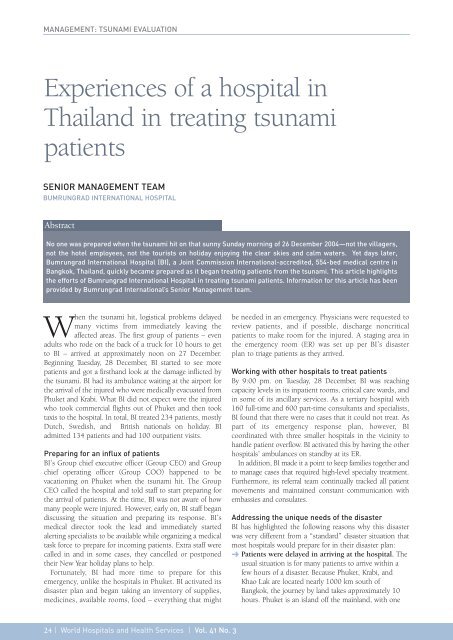World Hospitals and Health Services - International Hospital ...
World Hospitals and Health Services - International Hospital ...
World Hospitals and Health Services - International Hospital ...
You also want an ePaper? Increase the reach of your titles
YUMPU automatically turns print PDFs into web optimized ePapers that Google loves.
MANAGEMENT: TSUNAMI EVALUATION<br />
Experiences of a hospital in<br />
Thail<strong>and</strong> in treating tsunami<br />
patients<br />
SENIOR MANAGEMENT TEAM<br />
BUMRUNGRAD INTERNATIONAL HOSPITAL<br />
Abstract<br />
No one was prepared when the tsunami hit on that sunny Sunday morning of 26 December 2004—not the villagers,<br />
not the hotel employees, not the tourists on holiday enjoying the clear skies <strong>and</strong> calm waters. Yet days later,<br />
Bumrungrad <strong>International</strong> <strong>Hospital</strong> (BI), a Joint Commission <strong>International</strong>-accredited, 554-bed medical centre in<br />
Bangkok, Thail<strong>and</strong>, quickly became prepared as it began treating patients from the tsunami. This article highlights<br />
the efforts of Bumrungrad <strong>International</strong> <strong>Hospital</strong> in treating tsunami patients. Information for this article has been<br />
provided by Bumrungrad <strong>International</strong>’s Senior Management team.<br />
When the tsunami hit, logistical problems delayed<br />
many victims from immediately leaving the<br />
affected areas. The first group of patients – even<br />
adults who rode on the back of a truck for 10 hours to get<br />
to BI – arrived at approximately noon on 27 December.<br />
Beginning Tuesday, 28 December, BI started to see more<br />
patients <strong>and</strong> got a firsth<strong>and</strong> look at the damage inflicted by<br />
the tsunami. BI had its ambulance waiting at the airport for<br />
the arrival of the injured who were medically evacuated from<br />
Phuket <strong>and</strong> Krabi. What BI did not expect were the injured<br />
who took commercial flights out of Phuket <strong>and</strong> then took<br />
taxis to the hospital. In total, BI treated 234 patients, mostly<br />
Dutch, Swedish, <strong>and</strong> British nationals on holiday. BI<br />
admitted 134 patients <strong>and</strong> had 100 outpatient visits.<br />
Preparing for an influx of patients<br />
BI’s Group chief executive officer (Group CEO) <strong>and</strong> Group<br />
chief operating officer (Group COO) happened to be<br />
vacationing on Phuket when the tsunami hit. The Group<br />
CEO called the hospital <strong>and</strong> told staff to start preparing for<br />
the arrival of patients. At the time, BI was not aware of how<br />
many people were injured. However, early on, BI staff began<br />
discussing the situation <strong>and</strong> preparing its response. BI’s<br />
medical director took the lead <strong>and</strong> immediately started<br />
alerting specialists to be available while organizing a medical<br />
task force to prepare for incoming patients. Extra staff were<br />
called in <strong>and</strong> in some cases, they cancelled or postponed<br />
their New Year holiday plans to help.<br />
Fortunately, BI had more time to prepare for this<br />
emergency, unlike the hospitals in Phuket. BI activated its<br />
disaster plan <strong>and</strong> began taking an inventory of supplies,<br />
medicines, available rooms, food – everything that might<br />
be needed in an emergency. Physicians were requested to<br />
review patients, <strong>and</strong> if possible, discharge noncritical<br />
patients to make room for the injured. A staging area in<br />
the emergency room (ER) was set up per BI’s disaster<br />
plan to triage patients as they arrived.<br />
Working with other hospitals to treat patients<br />
By 9:00 pm. on Tuesday, 28 December, BI was reaching<br />
capacity levels in its inpatient rooms, critical care wards, <strong>and</strong><br />
in some of its ancillary services. As a tertiary hospital with<br />
160 full-time <strong>and</strong> 600 part-time consultants <strong>and</strong> specialists,<br />
BI found that there were no cases that it could not treat. As<br />
part of its emergency response plan, however, BI<br />
coordinated with three smaller hospitals in the vicinity to<br />
h<strong>and</strong>le patient overflow. BI activated this by having the other<br />
hospitals’ ambulances on st<strong>and</strong>by at its ER.<br />
In addition, BI made it a point to keep families together <strong>and</strong><br />
to manage cases that required high-level specialty treatment.<br />
Furthermore, its referral team continually tracked all patient<br />
movements <strong>and</strong> maintained constant communication with<br />
embassies <strong>and</strong> consulates.<br />
Addressing the unique needs of the disaster<br />
BI has highlighted the following reasons why this disaster<br />
was very different from a “st<strong>and</strong>ard” disaster situation that<br />
most hospitals would prepare for in their disaster plan:<br />
➜ Patients were delayed in arriving at the hospital. The<br />
usual situation is for many patients to arrive within a<br />
few hours of a disaster. Because Phuket, Krabi, <strong>and</strong><br />
Khao Lak are located nearly 1000 km south of<br />
Bangkok, the journey by l<strong>and</strong> takes approximately 10<br />
hours. Phuket is an isl<strong>and</strong> off the mainl<strong>and</strong>, with one<br />
24 | <strong>World</strong> <strong><strong>Hospital</strong>s</strong> <strong>and</strong> <strong>Health</strong> <strong>Services</strong> | Vol. 41 No. 3

















